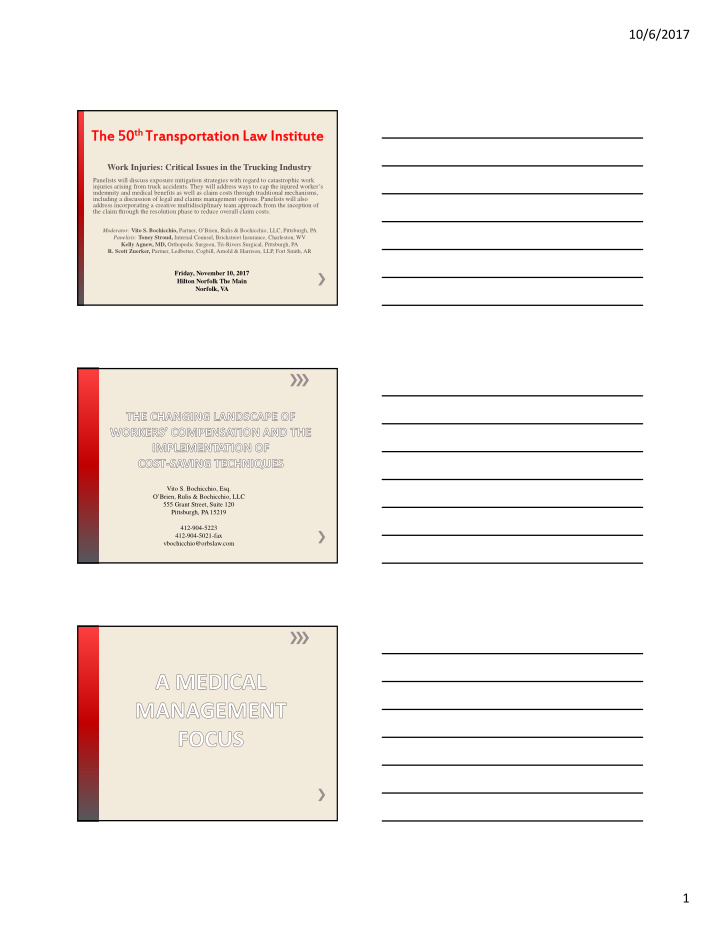



10/6/2017 The 50 th th Transportation L The 50 ansportation Law I w Institute stitute Work Injuries: Critical Issues in the Trucking Industry Panelists will discuss exposure mitigation strategies with regard to catastrophic work injuries arising from truck accidents. They will address ways to cap the injured worker’s indemnity and medical benefits as well as claim costs through traditional mechanisms, including a discussion of legal and claims management options. Panelists will also address incorporating a creative multidisciplinary team approach from the inception of the claim through the resolution phase to reduce overall claim costs. Moderator: Vito S. Bochicchio, Partner, O’Brien, Rulis & Bochicchio, LLC, Pittsburgh, PA Panelists: Toney Stroud, Internal Counsel, Brickstreet Insurance, Charleston, WV Kelly Agnew, MD, Orthopedic Surgeon, Tri-Rivers Surgical, Pittsburgh, PA R. Scott Zuerker, Partner, Ledbetter, Cogbill, Arnold & Harrison, LLP, Fort Smith, AR Friday, November 10, 2017 Hilton Norfolk The Main Norfolk, VA Vito S. Bochicchio, Esq. O’Brien, Rulis & Bochicchio, LLC 555 Grant Street, Suite 120 Pittsburgh, PA 15219 412-904-5223 412-904-5021-fax vbochicchio@orbslaw.com 1
10/6/2017 INTRODUCTION Since 2008, the U.S. experienced an unparalleled downturn in the economy not seen since the Great Depression. As a result, the following are factors that impacted employer’s workers’ compensation programs: • Increased Claim Costs • Tighter Budgets for Self-Insureds and Insurance Carriers • Increased claim costs per claim are going up as well as increased costs of 3% to 5% for programs Workers Compensation Benefits & Costs WHAT’S HAPPENING WITH EMPLOYERS’ COSTS? • Employer costs such as insurance premiums, deductibles, and administrative costs are RISING. $1.25 $1.35 (2010) (2014) (per $100 of payroll) ARE BENEFITS PAID GOING UP OR DOWN? • DOWN. Employee benefits as a share of payroll are at a historic low. $1.01 $0.91 (2010) (2014) (per $100 of payroll) THE QUESTION BECOMES: Q: What do we as an industry focus on to reduce costs? Medical Management A: 2
10/6/2017 MEDICAL COSTS SHARE OF TOTAL COST IS INCREASING STEADILY 2006 1996 1986 Source: NCCI (based on states where NCCI provides ratemaking services) WC MEDICAL COSTS WILL EQUAL 70% OF TOTAL BY 2016 IF TRENDS HOLD WC med costs could equal 70% of system costs by 2016 Estimate 2016. This means that claims severity will accelerate and claims management will become progressively more difficult and complex. Source: Insurance Information Institute Comorbid Impact WC Medical Claims Costs are 6.8x Higher for the Most Obese Workers $59,178 $70,000 $51,091 Indemnity costs are 11 times higher for the most obese $60,000 workers than for healthy ‐ $34,293 $50,000 weight workers. $40,000 $23,633 $23,373 $19,661 $30,000 $13,338 $13,569 $7,109 $7,503 $20,000 $5,396 $3,924 $10,000 $0 BMI <18.5 18.5-24.9 25-29.9 30-34.9 (Obese 35-39.9 (Obese 40+ (Obese (Underweight) (Healthy Weight) (Overweight) Class I) Class II) Class II) Medical Claims Costs Indemnity Claims Costs Source: Ostbye, T., et al , “Obesity and Workers Compensation,” J. of the American Medical Association , April 23, 2007 . 3
10/6/2017 Example: Obesity Obesity is the most important risk factor for sleep apnea. Source: Hypertension (2003) There is a correlation between weight loss and reduction in AHI (Apnea Hypopnea Index). Source: Journal of Respiratory and Critical Care Medicine (2002) Data suggests that obesity is higher among the commercial driving population than the general population in the United States. Source: Atlas Ergonomic Study (2009) Example: Obesity • Obesity has been linked to sleep apnea in truck drivers • 2.4 Million to 3.9 Million licensed commerical drivers “are expected to” suffer from sleep apnea according to a recent Harvard study • Data suggests that sleep apnea accounts for thousands of motor vehicle accidents per year Source: Journal of Occupational and Environmental Medicine, March 2009 Trucking, Rail, Air and Beyond…… Although there have not been in ‐ depth studies done in the airline and railroad industries, the risk associated with sleep apnea is recognized as a important factor with regard to human error in relationship to accidents. 4
10/6/2017 PREVENTING INJURY WELLNESS PROGRAMS “Health Management efforts…are essential especially in light of the workforce characteristics and economic challenges faced by the trucking industry today.” – Dr. Khan, Medical National Director, Concentra Total Care Screening (identifying the health issues and risk factors for your work force/employees) Getting employees to the appropriate medical professional for treatment Educating/coaching employees on how to make lifestyle changes Utilizing effective incentives Source: Concentra Newsroom “Fit to Drive” (2009) PREVENTING INJURY WELLNESS PROGRAMS Savings in Traditional Healthcare Costs • Example: Effective treatment for sleep apnea for commercial motor vehicle poplution (Decrease in Health Costs) 1. $2,700 the first year 2. $3,100 the second year 3. No cost savings for untreated drivers The savings on workers’ compensation programs incalculable Source: Journal of Occupational and Environmental Medicine (2010) MEDICAL MANAGEMENT POST INJURY • The treating physician directly impacts the duration of lost time and the utilization of health care resources • Effective loss control must have the ability to alter physician behavior • Nurse Case Management and/or Physician to Physician interaction can reduce the interaction cost by 25% 5
10/6/2017 AVERAGE COST SAVINGS WITH PHYSICIAN TO PHYSICIAN MODEL • Savings: • Workers’ Compensation - 25% HOW? 1. Getting injured workers back to work quickly reducing indemnity exposure 2. Prudent utilization of health care resources Source: IMC, a Highmark Company Litigation Considerations • Obtain all PCP records • Obtain a thorough past medical history • Investigate for pre-existing conditions • Utilize hospital canvas searches • Obtain ISO Reports on each case • Obtain pre-employment physical • Make sure that the insurance carrier or TPA have Injured Worker Questionnaires that are comprehensive so this information can be obtained at the initial investigative level prior to a determination of whether or not to accept the workers’ compensation claim as being compensable. (See Example) 6
Recommend
More recommend